Abstract
1. The affinities of urapidil derivatives and other antagonists for alpha 1-adrenoceptors labelled by [3H]-prazosin were determined on membranes of six different rat tissues. 2. Urapidil and its 5-acetyl-, 5-formyl- and 5-methyl-derivative displaced [3H]-prazosin from alpha 1-adrenoceptor binding sites in a concentration-dependent manner which varied with tissue. IC50 values were lower in vas deferens, hippocampus and cerebral cortex than in heart, liver and spleen. For 5-methyl-urapidil, binding to two distinct sites could be demonstrated with mean K1 values of about 0.6 and 45 nM. Saturation binding studies with [3H]-prazosin in the presence of 5-methyl-urapidil indicated a competitive type of interaction between 5-methyl-urapidil and [3H]-prazosin. 3. The proportion of [3H]-prazosin binding sites with high affinity for 5-methyl-urapidil was 58% in vas deferens, 69% in hippocampus, 41% in cerebral cortex and 23% in myocardium. In liver and spleen virtually no high affinity sites were found. These values were in good agreement with the percentages of binding sites with high affinities for WB-4101 and phentolamine, indicating that all these antagonists bind to the same subtype of alpha 1-recognition sites, whereas other alpha-antagonists like BE 2254, yohimbine and unlabelled prazosin did not discriminate between two binding sites. 4. Preincubating membranes of the cerebral cortex with chloroethylclonidine preferentially inactivated [3H]-prazosin binding sites with low affinity for 5-methyl-urapidil. 5. The antagonist potencies of 5-methyl-urapidil and WB-4101 against alpha 1- adrenoceptor-mediated contractile responses were higher in vas deferens than in myocardium. The alpha 1-mediated effects in vas deferens but not in the heart were highly susceptible to nitrendipine. 6. Using 5-methyl-urapidil, the existence of two distinct alpha 1-adrenoceptor recognition sites could be demonstrated which correspond to the proposed alpha 1A- and alpha 1B-subtypes.(ABSTRACT TRUNCATED AT 400 WORDS)
Full text
PDF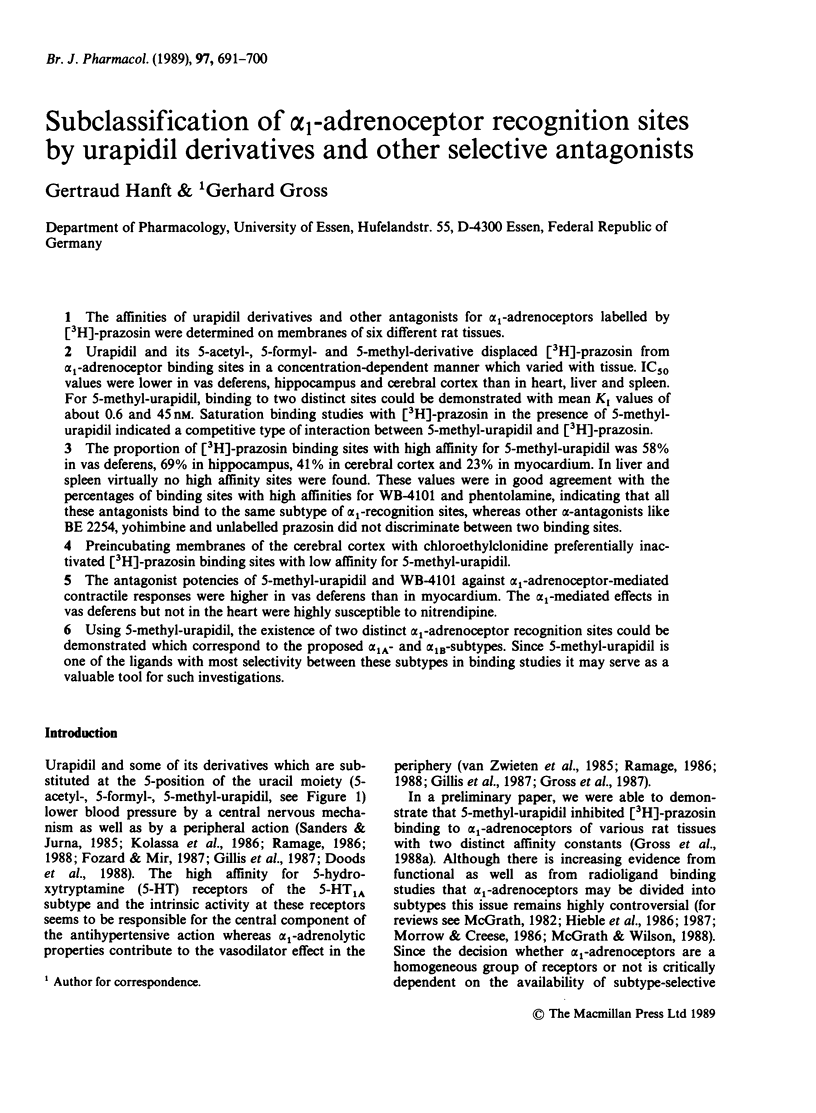
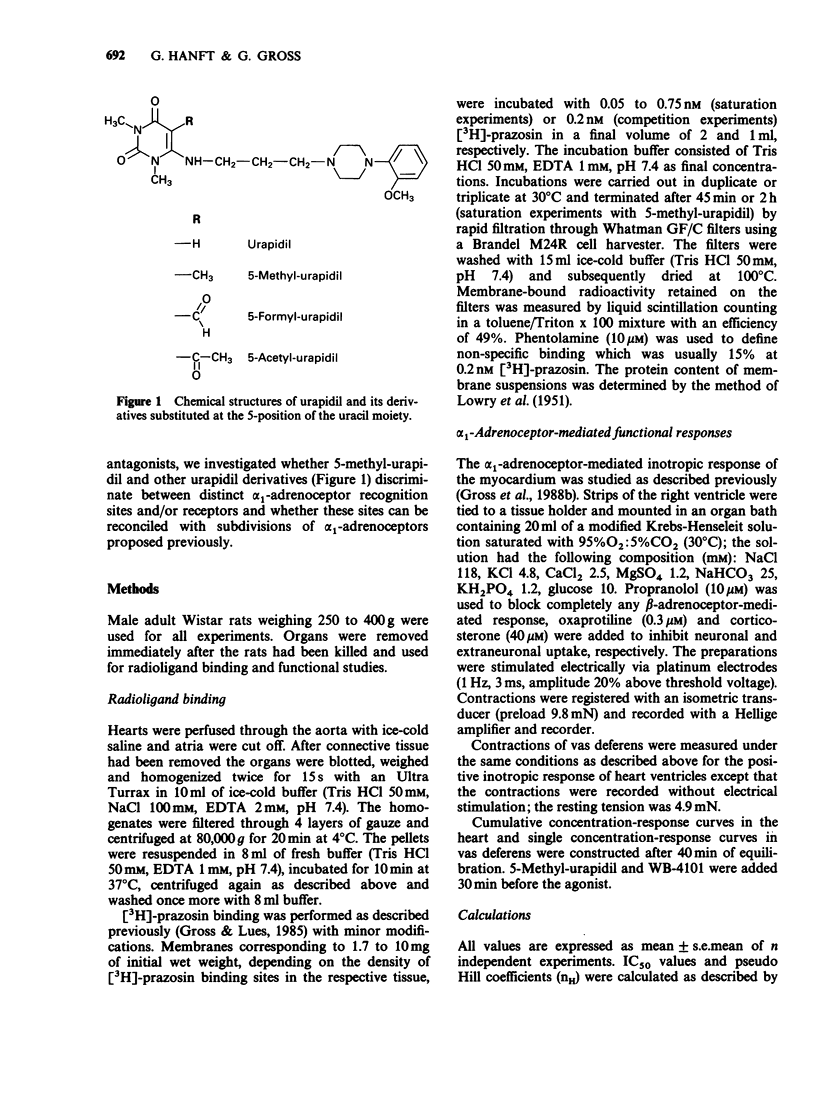
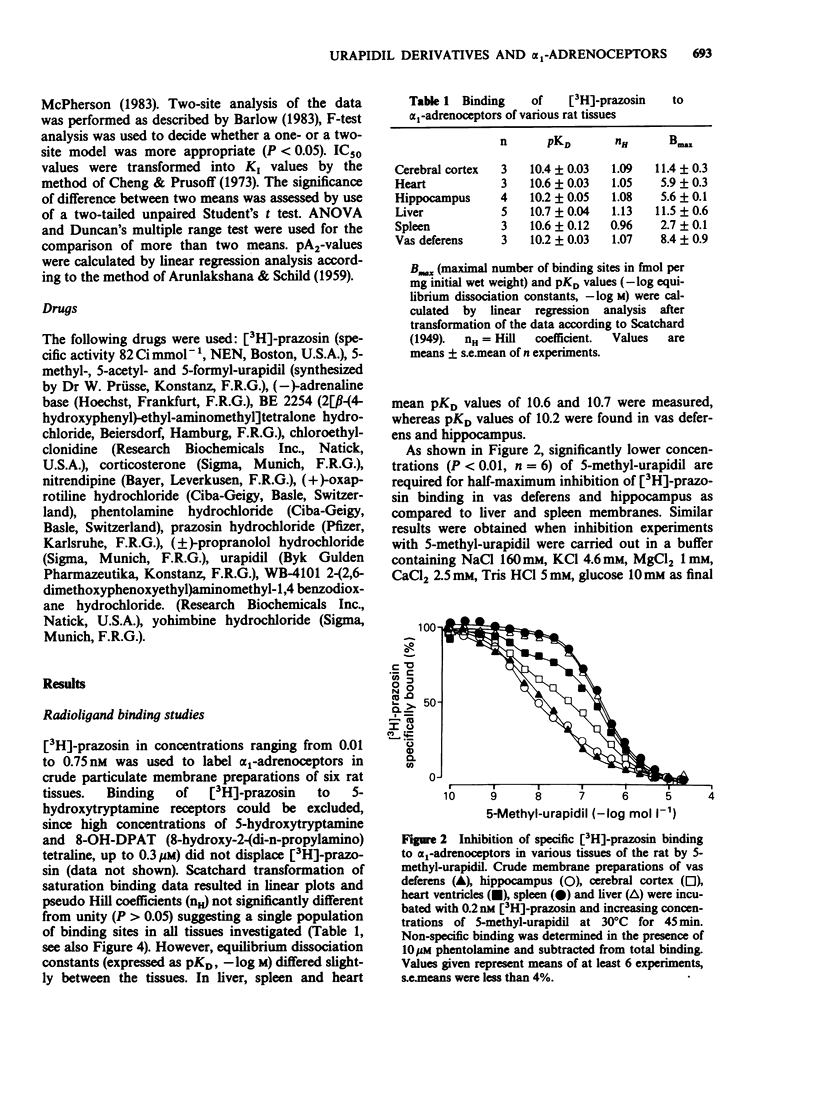
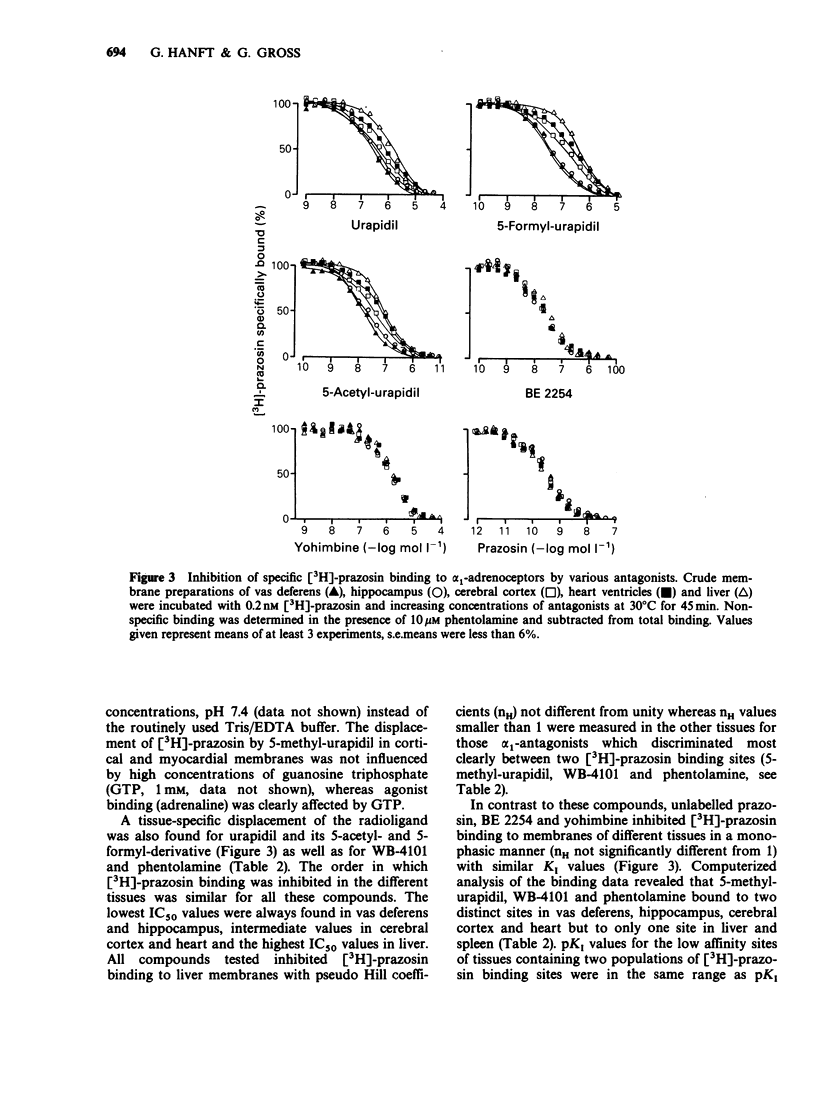
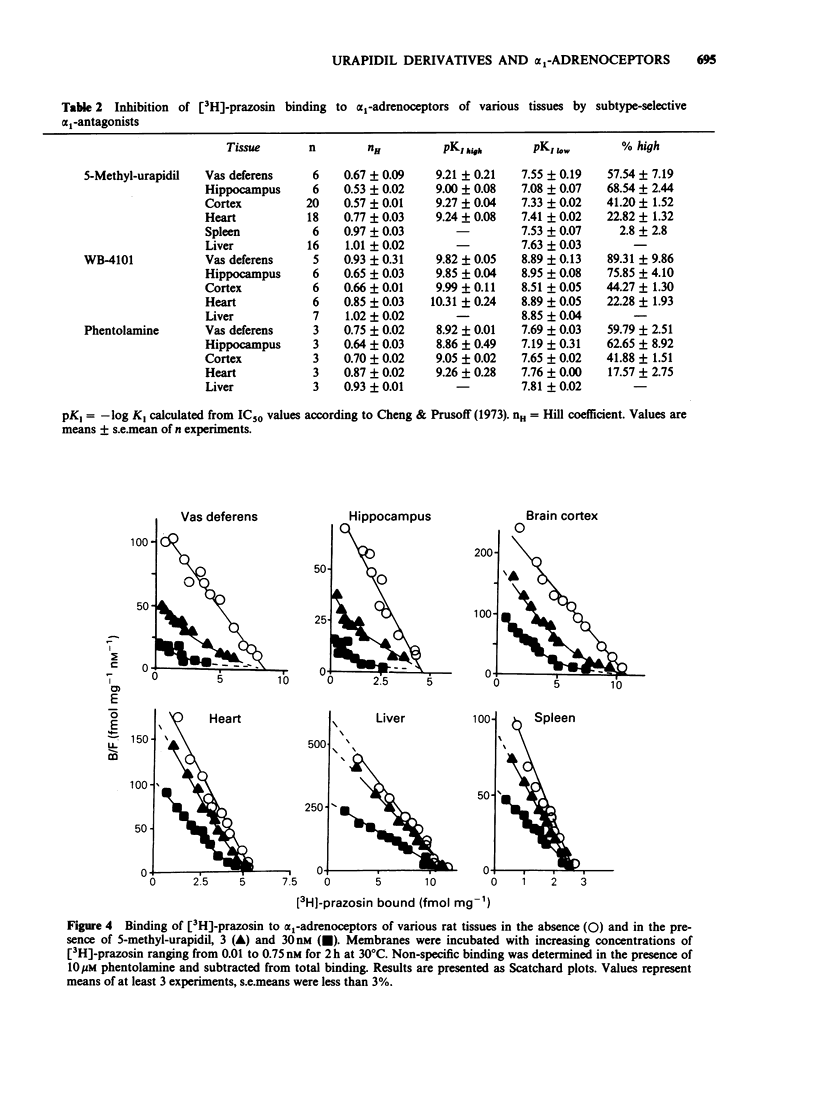

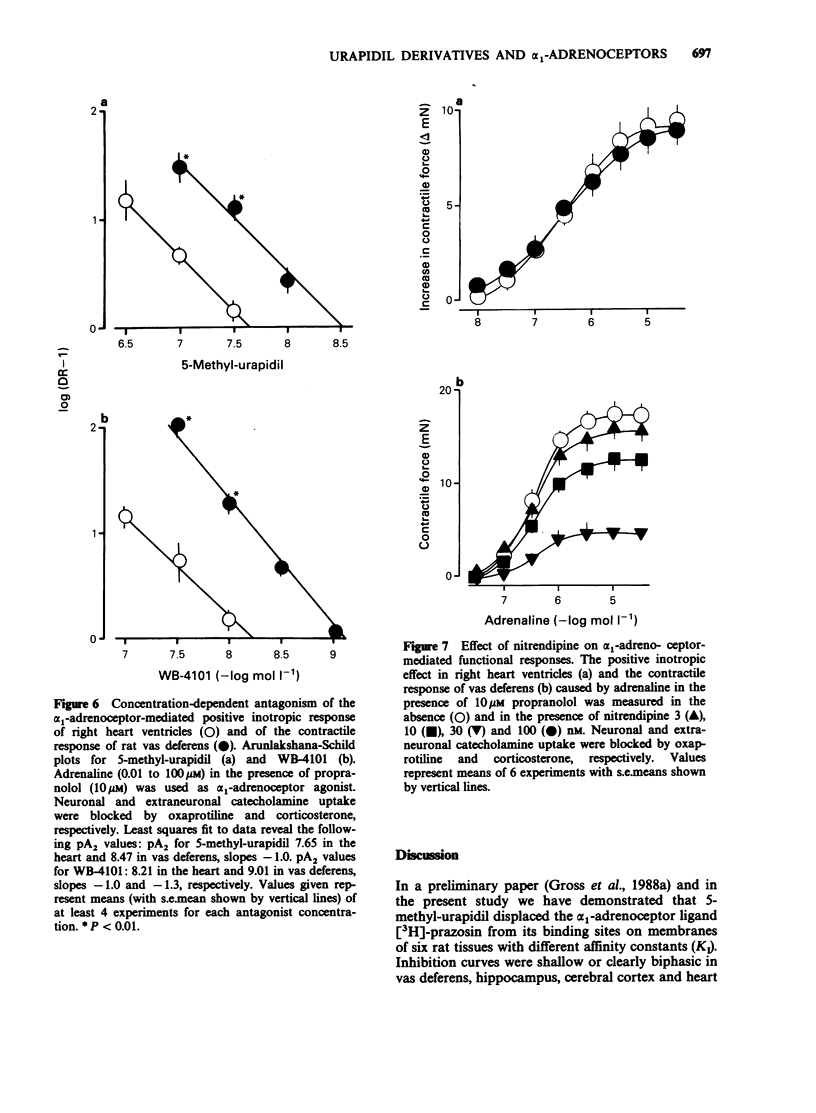
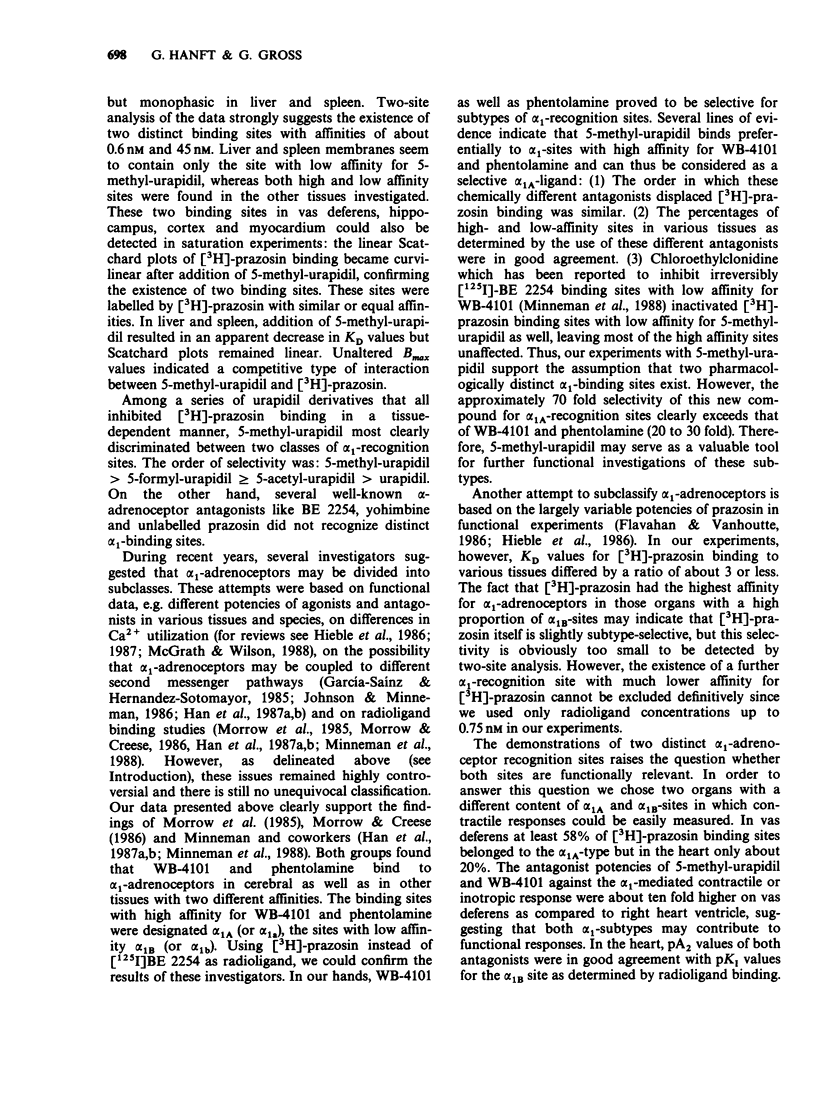
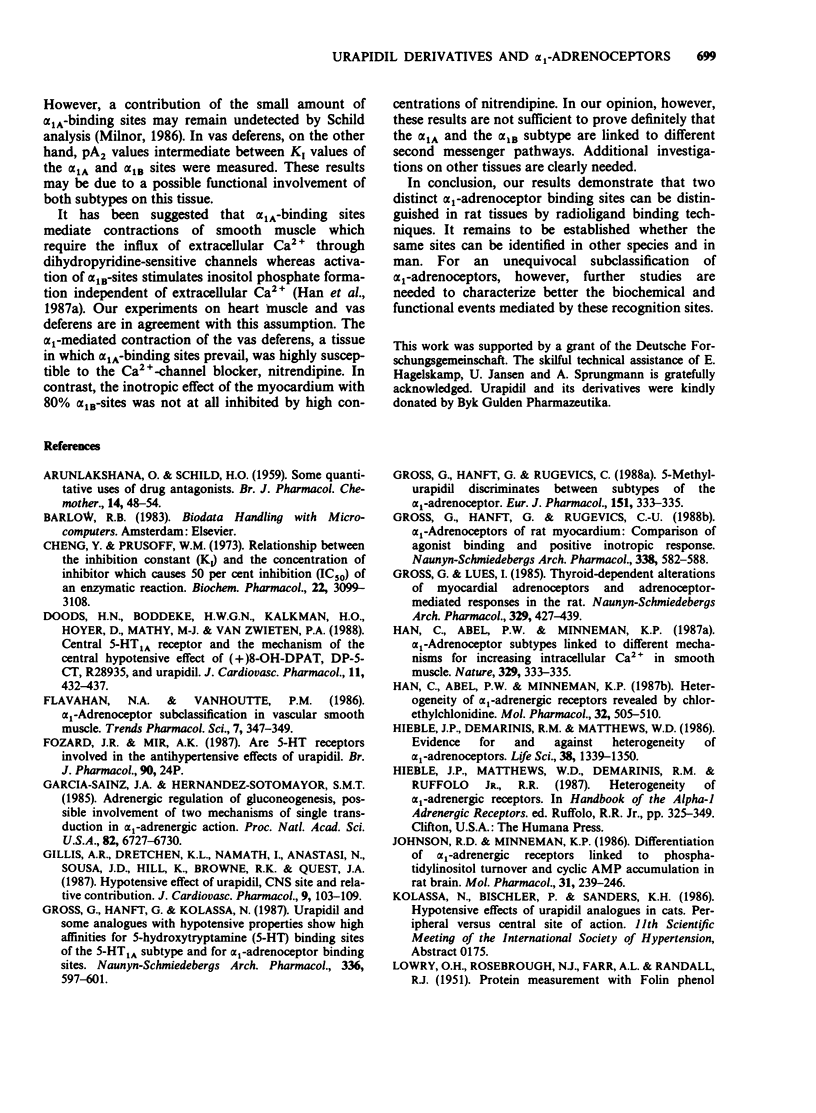

Selected References
These references are in PubMed. This may not be the complete list of references from this article.
- ARUNLAKSHANA O., SCHILD H. O. Some quantitative uses of drug antagonists. Br J Pharmacol Chemother. 1959 Mar;14(1):48–58. doi: 10.1111/j.1476-5381.1959.tb00928.x. [DOI] [PMC free article] [PubMed] [Google Scholar]
- Cheng Y., Prusoff W. H. Relationship between the inhibition constant (K1) and the concentration of inhibitor which causes 50 per cent inhibition (I50) of an enzymatic reaction. Biochem Pharmacol. 1973 Dec 1;22(23):3099–3108. doi: 10.1016/0006-2952(73)90196-2. [DOI] [PubMed] [Google Scholar]
- Doods H. N., Boddeke H. W., Kalkman H. O., Hoyer D., Mathy M. J., van Zwieten P. A. Central 5-HT1A receptors and the mechanism of the central hypotensive effect of (+)8-OH-DPAT, DP-5-CT, R28935, and urapidil. J Cardiovasc Pharmacol. 1988 Apr;11(4):432–437. doi: 10.1097/00005344-198804000-00008. [DOI] [PubMed] [Google Scholar]
- García-Sáinz J. A., Hernández-Sotomayor S. M. Adrenergic regulation of gluconeogenesis: possible involvement of two mechanisms of signal transduction in alpha 1-adrenergic action. Proc Natl Acad Sci U S A. 1985 Oct;82(20):6727–6730. doi: 10.1073/pnas.82.20.6727. [DOI] [PMC free article] [PubMed] [Google Scholar]
- Gillis R. A., Dretchen K. L., Namath I., Anastasi N., Dias Souza J., Hill K., Browne R. K., Quest J. A. Hypotensive effect of urapidil: CNS site and relative contribution. J Cardiovasc Pharmacol. 1987 Jan;9(1):103–109. [PubMed] [Google Scholar]
- Gross G., Hanft G., Kolassa N. Urapidil and some analogues with hypotensive properties show high affinities for 5-hydroxytryptamine (5-HT) binding sites of the 5-HT1A subtype and for alpha 1-adrenoceptor binding sites. Naunyn Schmiedebergs Arch Pharmacol. 1987 Dec;336(6):597–601. doi: 10.1007/BF00165749. [DOI] [PubMed] [Google Scholar]
- Gross G., Hanft G., Rugevics C. U. Alpha 1-adrenoceptors of rat myocardium: comparison of agonist binding and positive inotropic response. Naunyn Schmiedebergs Arch Pharmacol. 1988 Nov;338(5):582–588. doi: 10.1007/BF00179334. [DOI] [PubMed] [Google Scholar]
- Gross G., Hanft G., Rugevics C. 5-Methyl-urapidil discriminates between subtypes of the alpha 1-adrenoceptor. Eur J Pharmacol. 1988 Jul 7;151(2):333–335. doi: 10.1016/0014-2999(88)90819-9. [DOI] [PubMed] [Google Scholar]
- Gross G., Lues I. Thyroid-dependent alterations of myocardial adrenoceptors and adrenoceptor-mediated responses in the rat. Naunyn Schmiedebergs Arch Pharmacol. 1985 Jun;329(4):427–439. doi: 10.1007/BF00496378. [DOI] [PubMed] [Google Scholar]
- Han C., Abel P. W., Minneman K. P. Alpha 1-adrenoceptor subtypes linked to different mechanisms for increasing intracellular Ca2+ in smooth muscle. Nature. 1987 Sep 24;329(6137):333–335. doi: 10.1038/329333a0. [DOI] [PubMed] [Google Scholar]
- Han C., Abel P. W., Minneman K. P. Heterogeneity of alpha 1-adrenergic receptors revealed by chlorethylclonidine. Mol Pharmacol. 1987 Oct;32(4):505–510. [PubMed] [Google Scholar]
- Hieble J. P., DeMarinis R. M., Matthews W. D. Evidence for and against heterogeneity of alpha 1-adrenoceptors. Life Sci. 1986 Apr 14;38(15):1339–1350. doi: 10.1016/0024-3205(86)90466-2. [DOI] [PubMed] [Google Scholar]
- Johnson R. D., Minneman K. P. Differentiation of alpha 1-adrenergic receptors linked to phosphatidylinositol turnover and cyclic AMP accumulation in rat brain. Mol Pharmacol. 1987 Mar;31(3):239–246. [PubMed] [Google Scholar]
- McGrath J. C. Evidence for more than one type of post-junctional alpha-adrenoceptor. Biochem Pharmacol. 1982 Feb 15;31(4):467–484. doi: 10.1016/0006-2952(82)90147-2. [DOI] [PubMed] [Google Scholar]
- McGrath J., Wilson V. Alpha-adrenoceptor subclassification by classical and response-related methods: same question, different answers. Trends Pharmacol Sci. 1988 May;9(5):162–165. doi: 10.1016/0165-6147(88)90030-2. [DOI] [PubMed] [Google Scholar]
- McPherson G. A. A practical computer-based approach to the analysis of radioligand binding experiments. Comput Programs Biomed. 1983 Aug-Oct;17(1-2):107–113. doi: 10.1016/0010-468x(83)90031-4. [DOI] [PubMed] [Google Scholar]
- Milnor W. R. Limitations of Schild plots in a two-receptor system: alpha adrenoceptors of vascular smooth muscle. J Pharmacol Exp Ther. 1986 Jul;238(1):237–241. [PubMed] [Google Scholar]
- Minneman K. P., Han C., Abel P. W. Comparison of alpha 1-adrenergic receptor subtypes distinguished by chlorethylclonidine and WB 4101. Mol Pharmacol. 1988 May;33(5):509–514. [PubMed] [Google Scholar]
- Morrow A. L., Battaglia G., Norman A. B., Creese I. Identification of subtypes of [3H]prazosin-labelled alpha 1 receptor binding sites in rat brain. Eur J Pharmacol. 1985 Feb 26;109(2):285–287. doi: 10.1016/0014-2999(85)90432-7. [DOI] [PubMed] [Google Scholar]
- Morrow A. L., Creese I. Characterization of alpha 1-adrenergic receptor subtypes in rat brain: a reevaluation of [3H]WB4104 and [3H]prazosin binding. Mol Pharmacol. 1986 Apr;29(4):321–330. [PubMed] [Google Scholar]
- Ramage A. G. A comparison of the effects of doxazosin and alfuzosin with those of urapidil on preganglionic sympathetic nerve activity in anaesthetised cats. Eur J Pharmacol. 1986 Oct 7;129(3):307–314. doi: 10.1016/0014-2999(86)90440-1. [DOI] [PubMed] [Google Scholar]
- Ramage A. G. Are drugs that act both on serotonin receptors and alpha 1-adrenoceptors more potent hypotensive agents than those that act only on alpha 1-adrenoceptors? J Cardiovasc Pharmacol. 1988;11 (Suppl 1):S30–S34. [PubMed] [Google Scholar]
- Sanders K. H., Jurna I. Effects of urapidil, clonidine, prazosin and propranolol on autonomic nerve activity, blood pressure and heart rate in anaesthetized rats and cats. Eur J Pharmacol. 1985 Apr 2;110(2):181–190. doi: 10.1016/0014-2999(85)90210-9. [DOI] [PubMed] [Google Scholar]
- van Zwieten P. A., de Jonge A., Wilffert B., Timmermans P. B., Beckeringh J. J., Thoolen M. J. Cardiovascular effects and interaction with adrenoceptors of urapidil. Arch Int Pharmacodyn Ther. 1985 Aug;276(2):180–201. [PubMed] [Google Scholar]


